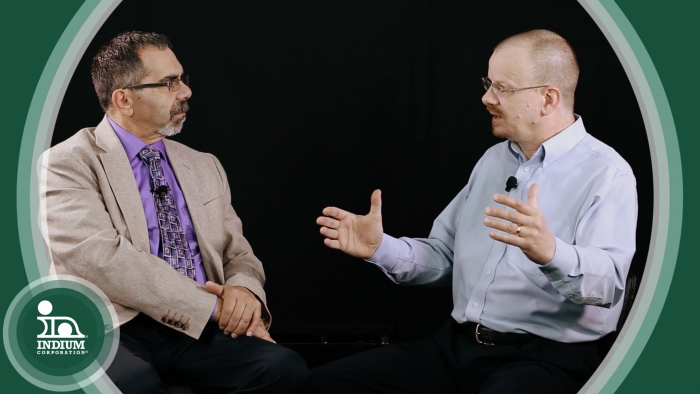Phil Zarrow: This video is for anyone interested in the flux challenges with regard to flip-chip/BGA balling.
Andy, with regard to flip-chip/BGA balling, what are some of the challenges for the flux?
Andy C. Mackie, PhD MSc: Clearly solderability is a major one for customers. We have to have very good joint strength and we have to have no missing ball. That means that the balls have to remain in place where they're placed, and a long consistent usage life for the material, particularly the pin transfer, is critical, and finally cleanability.
Phil Zarrow: Now pin transfer, elaborate a little bit.
Andy C. Mackie, PhD MSc: Pin transfer is where you have a substrate that's probably pretty large. BGA substrates are singulated later on, but the palletization of them can be very large. And when you're printing onto an area that's very uneven, as BGA substrates usually are after the processing steps, it can be a real challenge to print onto them. So pin transfer, which uses spring-loaded pins to transfer the pin from from a dip tray onto the substrate, that gives us an opportunity to put flux onto very noncompliant substrate.
It's very important for the viscosity of the material, which is isotropic in nature, not to increase in viscosity. It's also critical for the material not to increase in tack over time. And that's where our WS575-C-RT material is proving very useful over competitor materials.
Phil Zarrow: Very good. How does it work with regard to cleanability?
Andy C. Mackie, PhD MSc: Cleanability is very important. Customers these days are now asking for room temperature and much lower temperature cleanability. There was a belief that you had to go to higher temperatures for cleanability, particularly with some of the more challenging water-soluble materials, after some of the more challenging, more punishing, treatments of the substrates and we've proven, using standard techniques such as the secondary ion mass spectrometry, or SIMS, that our materials are cleanable even after, again, some of the more challenging pre-treatments of the substrate. So you end up with a pure copper surface instead of carbon and oxygen being present on the surface.
Phil Zarrow: Where can we get more information, Andy?
Andy C. Mackie, PhD MSc: As always, go to www.indium.com or email me at amackie@indium.com.
Phil Zarrow: Excellent. Very informative. Thank you, Andy.
Andy C. Mackie, PhD MSc: Phil, thank you.
Phil Zarrow: Take care.


